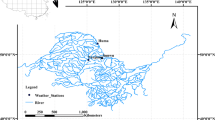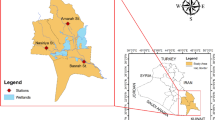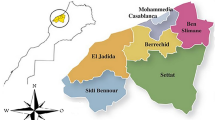Abstract
This study investigates the projections of precipitation and temperature at the local scale in the Upper Indus Basin (UIB) in Pakistan using six Regional Climate Models (RCMs) from CORDEX under two Representative Concentration Pathways (RCP 4.5 and RCP 8.5). For twenty-four stations spread across the study area, the Long Ashton Research Station Weather Generator, version six (LARS-WG6), was used to downscale the daily data from the six different RCMs for maximum temperature (Tmax), minimum temperature (Tmin), and precipitation (pr) at a spatial resolution of 0.44°. Investigations were made to predict changes in mean annual values of Tmax, Tmin, and precipitation during two future periods, i.e., the mid-century (2041–2070) and end-century (2071–2100). The model results from statistical and graphical comparison validated that the LARS-WG6 can simulate the temperature and the precipitation in the UIB. Each of the six RCMs and their ensemble revealed a continuously increased temperature projection in the basin; nevertheless, there is variation in projected magnitude across RCMs and between RCPs. The rise in average Tmax and Tmin was more significant under RCP 8.5 than RCP 4.5, possibly due to unmitigated greenhouse gas emissions (GHGs). The precipitation projections follow the non-uniform trend, i.e., not all RCMs agree on whether the precipitation will increase or decrease in the basin, and no orderly variations were detected during any future periods under any RCP. However, an overall increase in precipitation is projected by the ensemble of RCMs.











Similar content being viewed by others
Data availability
• The CORDEX data used in the study is available at https://esgf-node.llnl.gov/projects/esgf-llnl/
• The data used for the analysis in this study was obtained from the Pakistan Meteorological Department (PMD) and the Water and Power Development Authority (WAPDA), but restrictions apply to the availability of the data, which was used under permission for the current study only, and is not publicly available.
References
Abiodun, B. J., & Adedoyin, A. (2016). A modelling perspective of future climate change. In T. M. Letcher (Ed.), Climate Change (pp. 355–371). Elsevier.
Agarwal, A., Babel, M. S., & Maskey, S. (2014). Analysis of future precipitation in the Koshi river basin, Nepal. Journal of Hydrology, 513, 422–434.
Ahmad, B., & Rasul, G. (2018). Statistically downscaled projections of CORDEX South Asia using quantile mapping approach over Pakistan region. International Journal of Global Warming, 16(4), 435–460.
Akhtar, M., Ahmad, N., & Booij, M. J. (2008). The impact of climate change on the water resources of Hindukush–Karakorum–Himalaya region under different glacier coverage scenarios. Journal of Hydrology, 355(1), 148–163. https://doi.org/10.1016/j.jhydrol.2008.03.015
Ali, S., Li, D., Congbin, F., & Khan, F. (2015). Twenty first century climatic and hydrological changes over Upper Indus Basin of Himalayan region of Pakistan. Environmental Research Letters, 10(1), 014007.
Almazroui, M., Saeed, S., Saeed, F., Islam, M. N., & Ismail, M. (2020). Projections of precipitation and temperature over the South Asian countries in CMIP6. Earth Systems and Environment, 4, 297–320.
Alotaibi, K., Ghumman, A. R., Haider, H., Ghazaw, Y. M., & Shafiquzzaman, M. (2018). Future predictions of rainfall and temperature using GCM and ANN for arid regions: A case study for the Qassim Region, Saudi Arabia. Water, 10(9), 1260.
Baronetti, A., Dubreuil, V., Provenzale, A., & Fratianni, S. (2022). Future droughts in northern Italy: High-resolution projections using EURO-CORDEX and MED-CORDEX ensembles. Climatic Change, 172(3), 22. https://doi.org/10.1007/s10584-022-03370-7
Barros, V. R., Field, C. B., Dokken, D. J., Mastrandrea, M. D., Mach, K. J., Bilir, T. E., Chatterjee, M., Ebi, K. L., Estrada, Y. O., & Genova, R. C. (2014). Climate change 2014 impacts, adaptation, and vulnerability Part B: regional aspects: working group II contribution to the fifth assessment report of the intergovernmental panel on climate change. In Climate Change 2014: Impacts, Adaptation and Vulnerability: Part B: Regional Aspects: Working Group II Contribution to the Fifth Assessment Report of the Intergovernmental Panel on Climate Change (pp. 1–1820). Cambridge University Press. https://www.ipcc.ch/site/assets/uploads/2018/02/WGIIAR5-Chap21_FINAL.pdf
Bashir, F., Zeng, X., Gupta, H., & Hazenberg, P. (2017). A hydrometeorological perspective on the Karakoram anomaly using unique valley-based synoptic weather observations. Geophysical Research Letters, 44(20), 10–470.
Bayatvarkeshi, M., Zhang, B., Fasihi, R., Adnan, R. M., Kisi, O., & Yuan, X. (2020). Investigation into the effects of climate change on reference evapotranspiration using the HadCM3 and LARS-WG. Water, 12(3), 666.
Bookhagen, B., & Burbank, D. W. (2010). Toward a complete Himalayan hydrological budget: Spatiotemporal distribution of snowmelt and rainfall and their impact on river discharge. Journal of Geophysical Research: Earth Surface, 115(F3).
Bukovsky, M. S., & Mearns, L. O. (2020). Regional climate change projections from NA-CORDEX and their relation to climate sensitivity. Climatic Change, 162(2), 645–665.
Buytaert, W., Vuille, M., Dewulf, A., Urrutia, R., Karmalkar, A., & Célleri, R. (2010). Uncertainties in climate change projections and regional downscaling in the tropical Andes: Implications for water resources management. Hydrology and Earth System Sciences, 14(7), 1247–1258.
Chapagain, D., Dhaubanjar, S., & Bharati, L. (2021). Unpacking future climate extremes and their sectoral implications in western Nepal. Climatic Change, 168(1), 8. https://doi.org/10.1007/s10584-021-03216-8
Chen, H., Guo, J., Zhang, Z., & Xu, C.-Y. (2013). Prediction of temperature and precipitation in Sudan and South Sudan by using LARS-WG in future. Theoretical and Applied Climatology, 113, 363–375.
Dahri, Z. H., Ludwig, F., Moors, E., Ahmad, B., Khan, A., & Kabat, P. (2016). An appraisal of precipitation distribution in the high-altitude catchments of the Indus basin. Science of the Total Environment, 548, 289–306.
Daly, C. (2006). Guidelines for assessing the suitability of spatial climate data sets. International Journal of Climatology: A Journal of the Royal Meteorological Society, 26(6), 707–721.
De Souza, K., Kituyi, E., Harvey, B., Leone, M., Murali, K. S., & Ford, J. D. (2015). Vulnerability to climate change in three hot spots in Africa and Asia: key issues for policy-relevant adaptation and resilience-building research. Regional Environmental Change, 15, 747–753.
Ding, Y., Mu, M., Zhang, J., Jiang, T., Zhang, T., Wang, C., Wu, L., Ye, B., Bao, M., & Zhang, S. (2016). Impacts of climate change on the environment, economy, and society of China. In D. Qin, Y. Ding, & Mu Mu (Eds.), Climate and environmental change in China: 1951–2012 (pp. 69–92). Springer
Ehret, U., Zehe, E., Wulfmeyer, V., & Liebert, J. (2012). Should we apply bias correction to global and regional climate model data? HESS, 16, 3391–3404.
FentaMekonnen, D., & Disse, M. (2018). Analyzing the future climate change of Upper Blue Nile River basin using statistical downscaling techniques. Hydrology and Earth System Sciences, 22(4), 2391–2408.
Forsythe, N., Fowler, H. J., Blenkinsop, S., Burton, A., Kilsby, C. G., Archer, D. R., Harpham, C., & Hashmi, M. Z. (2014). Application of a stochastic weather generator to assess climate change impacts in a semi-arid climate: The Upper Indus Basin. Journal of Hydrology, 517, 1019–1034. https://doi.org/10.1016/j.jhydrol.2014.06.031
Fotso-Nguemo, T. C., Diallo, I., Diakhaté, M., Vondou, D. A., Mbaye, M. L., Haensler, A., Gaye, A. T., & Tchawoua, C. (2019). Projected changes in the seasonal cycle of extreme rainfall events from CORDEX simulations over Central Africa. Climatic Change, 155(3), 339–357. https://doi.org/10.1007/s10584-019-02492-9
Fowler, H. J., & Archer, D. R. (2006). Conflicting signals of climatic change in the Upper Indus Basin. Journal of Climate, 19(17), 4276–4293.
Fowler, H. J., Blenkinsop, S., & Tebaldi, C. (2007). Linking climate change modelling to impacts studies: Recent advances in downscaling techniques for hydrological modelling. International Journal of Climatology: A Journal of the Royal Meteorological Society, 27(12), 1547–1578.
Gerlitz, L., Schickhoff, U., Scholten, T., & Böhner, J. (2016). Recent climate change over High Asia. In R. B. Singh, U. Schickhoff, & S. Mal (Eds.), Climate change, glacier response, and vegetation dynamics in the Himalaya (pp. 29–48). Springer.
Guijarro, J. A. (2018). Homogenization of climatic series with Climatol. Reporte técnico State Meteorological Agency (AEMET), Balearic Islands Office, Spain
Harding, R. J., Weedon, G. P., van Lanen, H. A. J., & Clark, D. B. (2014). The future for global water assessment. Journal of Hydrology, 518, 186–193.
Hashmi, M. Z., Shamseldin, A. Y., & Melville, B. W. (2011). Comparison of SDSM and LARS-WG for simulation and downscaling of extreme precipitation events in a watershed. Stochastic Environmental Research and Risk Assessment, 25(4), 475–484.
Hassan, M., Du, P., Mahmood, R., Jia, S., & Iqbal, W. (2019). Streamflow response to projected climate changes in the Northwestern Upper Indus Basin based on regional climate model (RegCM4. 3) simulation. Journal of Hydro-Environment Research, 27, 32–49.
Hasson, SUl. (2016). Future water availability from Hindukush-Karakoram-Himalaya Upper Indus Basin under conflicting climate change scenarios. Climate, 4(3), 40.
Hasson, S., Böhner, J., & Lucarini, V. (2017). Prevailing climatic trends and runoff response from Hindukush–Karakoram–Himalaya, upper Indus Basin. Earth System Dynamics, 8(2), 337–355.
IPCC. (2013). The physical science basis. Contribution of Working Group I to the Fifth Assessment Report of the Intergovernmental Panel on Climate Change, 1535, 2013.
Ismail, M. F., Naz, B. S., Wortmann, M., Disse, M., Bowling, L. C., & Bogacki, W. (2020). Comparison of two model calibration approaches and their influence on future projections under climate change in the Upper Indus Basin. Climatic Change, 163(3), 1227–1246. https://doi.org/10.1007/s10584-020-02902-3
Karam, S., Seidou, O., Nagabhatla, N., Perera, D., & Tshimanga, R. M. (2022). Assessing the impacts of climate change on climatic extremes in the Congo River Basin. Climatic Change, 170(3), 40. https://doi.org/10.1007/s10584-022-03326-x
Kavwenje, S., Zhao, L., Chen, L., & Chaima, E. (2022). Projected temperature and precipitation changes using the LARS-WG statistical downscaling model in the Shire River Basin, Malawi. International Journal of Climatology, 42(1), 400–415.
Khan, F., Pilz, J., Amjad, M., & Wiberg, D. A. (2015). Climate variability and its impacts on water resources in the Upper Indus Basin under IPCC climate change scenarios. International Journal of Global Warming, 8(1), 46–69.
Kilroy, G. (2015). A review of the biophysical impacts of climate change in three hotspot regions in Africa and Asia. Regional Environmental Change, 15(5), 771–782.
Kim, G., Cha, D.-H., Lee, G., Park, C., Jin, C.-S., Lee, D.-K., Suh, M.-S., Ahn, J.-B., Min, S.-K., & Kim, J. (2020). Projection of future precipitation change over South Korea by regional climate models and bias correction methods. Theoretical and Applied Climatology, 141(3), 1415–1429.
Kulkarni, A., Patwardhan, S., Kumar, K. K., Ashok, K., & Krishnan, R. (2013). Projected climate change in the Hindu Kush-Himalayan region by using the high-resolution regional climate model PRECIS. Mountain Research and Development, 33(2), 142–151.
Kumar, P., Saharwardi, M. S., Banerjee, A., Azam, M. F., Dubey, A. K., & Murtugudde, R. (2019). Snowfall variability dictates glacier mass balance variability in Himalaya-Karakoram. Scientific Reports, 9(1), 18192.
Lee, D.-K., & Cha, D.-H. (2020). Regional climate modeling for Asia. Geoscience Letters, 7(1), 1–12.
Luhunga, P. M., Kijazi, A. L., Chang’a, L., Kondowe, A., Ng’Ongolo, H., & Mtongori, H. (2018). Climate change projections for Tanzania based on high-resolution regional climate models from the coordinated regional climate downscaling experiment (CORDEX)-Africa. Frontiers in Environmental Science, 6, 122.
Lutz, A. F., Immerzeel, W. W., Kraaijenbrink, P. D. A., Shrestha, A. B., & Bierkens, M. F. P. (2016a). Climate change impacts on the upper Indus hydrology: Sources, shifts and extremes. PLoS One, 11(11), e0165630.
Lutz, A. F., ter Maat, H. W., Biemans, H., Shrestha, A. B., Wester, P., & Immerzeel, W. W. (2016b). Selecting representative climate models for climate change impact studies: An advanced envelope-based selection approach. International Journal of Climatology, 36(12), 3988–4005.
Maussion, F., Scherer, D., Mölg, T., Collier, E., Curio, J., & Finkelnburg, R. (2014). Precipitation seasonality and variability over the Tibetan Plateau as resolved by the High Asia Reanalysis. Journal of Climate, 27(5), 1910–1927.
MRI. (2015). Elevation-dependent warming in mountain regions of the world. Nature Climate Change, 5(5), 424–430.
Nepal, S., & Shrestha, A. B. (2015). Impact of climate change on the hydrological regime of the Indus, Ganges and Brahmaputra river basins: A review of the literature. International Journal of Water Resources Development, 31(2), 201–218.
Ougahi, J. H., Cutler, M. E. J., & Cook, S. J. (2022). Modelling climate change impact on water resources of the Upper Indus Basin. Journal of Water and Climate Change, 13(2), 482–504.
Palazzi, E., von Hardenberg, J., Terzago, S., & Provenzale, A. (2015). Precipitation in the Karakoram-Himalaya: A CMIP5 view. Climate Dynamics, 45, 21–45.
Pepin, N. C., Arnone, E., Gobiet, A., Haslinger, K., Kotlarski, S., Notarnicola, C., Palazzi, E., Seibert, P., Serafin, S., & Schöner, W. (2022). Climate changes and their elevational patterns in the mountains of the world. Reviews of Geophysics, 60(1), e2020RG000730.
Pomee, M. S., & Hertig, E. (2021). Temperature projections over the Indus River basin of pakistan using statistical downscaling. Atmosphere, 12(2), 195.
Pomee, M. S., & Hertig, E. (2022). Precipitation projections over the Indus River Basin of Pakistan for the 21st century using a statistical downscaling framework. International Journal of Climatology, 42(1), 289–314.
Sarkar, J., Chicholikar, J. R., & Rathore, L. S. (2015). Predicting future changes in temperature and precipitation in arid climate of Kutch, Gujarat: analyses based on LARS-WG model. Current Science, 109, 2084–2093.
Semenov, M. A., Barrow, E. M., & Lars-Wg, A. (2002). A stochastic weather generator for use in climate impact studies (pp. 1–27). User Man Herts, UK.
Sha, J., Li, X., & Wang, Z.-L. (2019). Estimation of future climate change in cold weather areas with the LARS-WG model under CMIP5 scenarios. Theoretical and Applied Climatology, 137(3), 3027–3039.
Shah, M. I., Khan, A., Akbar, T. A., Hassan, Q. K., Khan, A. J., & Dewan, A. (2020). Predicting hydrologic responses to climate changes in highly glacierized and mountainous region Upper Indus Basin. Royal Society Open Science, 7(8), 191957.
Stott, P. A., & Kettleborough, J. A. (2002). Origins and estimates of uncertainty in predictions of twenty-first century temperature rise. Nature, 416(6882), 723–726.
Sunyer, M. A., Madsen, H., & Ang, P. H. (2012). A comparison of different regional climate models and statistical downscaling methods for extreme rainfall estimation under climate change. Atmospheric Research, 103, 119–128.
Tangang, F., Chung, J. X., Juneng, L., Salimun, E., Ngai, S. T., Jamaluddin, A. F., Mohd, M. S. F., Cruz, F., Narisma, G., & Santisirisomboon, J. (2020). Projected future changes in rainfall in Southeast Asia based on CORDEX–SEA multi-model simulations. Climate Dynamics, 55, 1247–1267.
Taylor, K. E. (2001). Summarizing multiple aspects of model performance in a single diagram. Journal of Geophysical Research: Atmospheres, 106(D7), 7183–7192.
Trzaska, S., & Schnarr, E. (2014). A review of downscaling methods for climate change projections. United States Agency for International Development by Tetra Tech ARD, pp. 1–42.
Wake, C. P. (1989). Glaciochemical investigations as a tool for determining the spatial and seasonal variation of snow accumulation in the central Karakoram, northern Pakistan. Annals of Glaciology, 13, 279–284.
Zhang, X., & Yang, F. (2004). RClimDex (1.0) user manual. Climate Research Branch Environment Canada, 22, 13–14.
Acknowledgements
The authors thank the Pakistan Meteorological Department (PMD) and the Water and Power Development Authority (WAPDA) of Pakistan for providing the meteorological data used in this research.
Author information
Authors and Affiliations
Contributions
All authors contributed to the study’s conception and design. Data collection and analysis were performed by Summera Fahmi Khan. The first draft of the manuscript was written by Summera Fahmi Khan. The draft was reviewed and edited by Dr. Usman Ali Naeem.
Corresponding author
Ethics declarations
All authors have read, understood, and have complied as applicable with the statement on "Ethical responsibilities of Authors" as found in the Instructions for Authors and are aware that, with minor exceptions, no changes can be made to authorship once the paper is submitted.
Competing interests
The authors declare no competing interests.
Additional information
Publisher's note
Springer Nature remains neutral with regard to jurisdictional claims in published maps and institutional affiliations.
Appendix
Rights and permissions
Springer Nature or its licensor (e.g. a society or other partner) holds exclusive rights to this article under a publishing agreement with the author(s) or other rightsholder(s); author self-archiving of the accepted manuscript version of this article is solely governed by the terms of such publishing agreement and applicable law.
About this article
Cite this article
Khan, S.F., Naeem, U.A. Future climate projections using the LARS-WG6 downscaling model over Upper Indus Basin, Pakistan. Environ Monit Assess 195, 810 (2023). https://doi.org/10.1007/s10661-023-11419-y
Received:
Accepted:
Published:
DOI: https://doi.org/10.1007/s10661-023-11419-y








